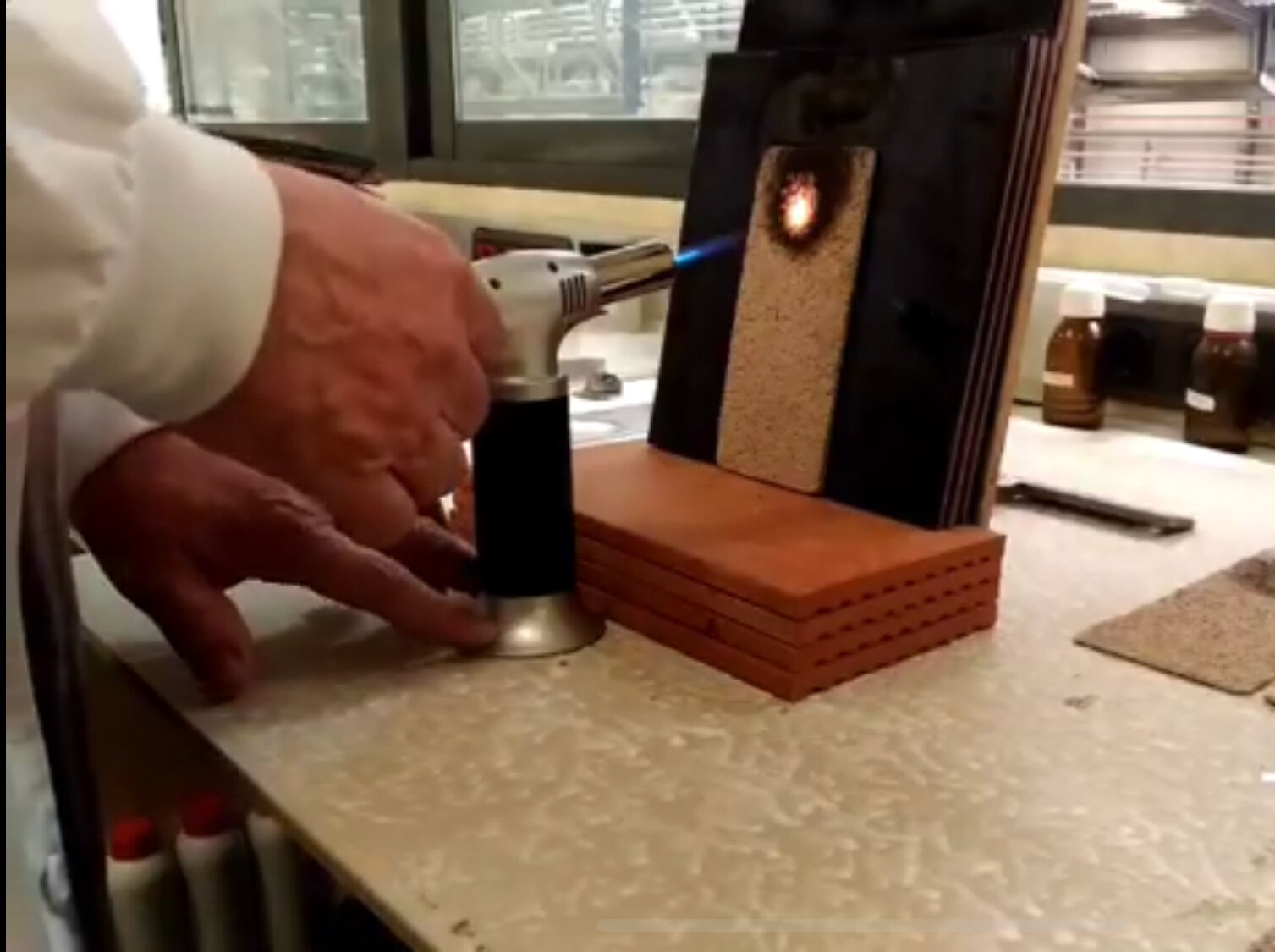
ECOrk HD
What is projected “ECOrk HD”
The product is a Projected Cork coating that is mixed 80% cork granules in a Polyacrylate Resin Polymer base.
Each cork cell is a 14 sided polyhedron filled with air, with an extremely strong membrane that is waterproof and air tight!!! The air volume of cork is around 89%, which allows for both acoustic and thermal insulation barrier. Cork is a natural impermeable , and contains an almost magical chemical which renders it impermeable to liquids and gases. This chemical is a fatty acid and a heavy organic alcohol called “Suberin” , which also does not rot or degrade. This chemical also resists Mold and Mildew.
Cork is the cortex of the Mediterranean cork oak “Quercus suber”, growing in the south of Europe and the north of the African coast. It is cultivated mainly in Portugal, Spain and Algeria.Cork extraction is made by withdrawing cork oak cortex, where the material is located. Once cortex is withdrawn, the tree is “at rest”, and nine years later the extracting process will be renewed.
Cork oak is a strong tree which can reach up to 20 or 25m high. Its cortex is suberized, that is to say, composed by cork, being relatively soft and spongy, very light-weighted and with deep cracks. Its cortex protects the tree from injuries, sicknesses and insects. It is a death tree part which protects the living one, most of all to survive drought (protecting internal tissues from water losses) and fires. When there is a fire, the internal cork side closes due to the heat and avoids oxygen entry and therefore combustion, protecting the tree internal parts, which enables it to regrow anew the next season.
“Ecork HD” can be applied several ways. The most common application process is through a Texture Spray Hopper or a Texture Spray Machine.
Raw cork being Harvested
Raw cork Being Harvested
Amazing Thermal Insulation Benefits
Thermal Insulation Properties
Fist off “ECOrk HD” qualifies in nature as a thermal insulation material
A thermal insulation material is a material used in building and industry, characterized by its high thermal resistance. It sets a barrier to avoid heat transfer between two means which naturally would tend to balance its temperatures.
In general, all those materials offer resistance to heat transfer, but to be considered as a thermal insulation material its thermal conductivity coefficient (λ) is to be under 0.10 W/m²·K (K rating) measured at 23°C.
Thermal insulation materials with thermal conductivity of < 0.10 W/m²·K measured at 23°C. are called specific thermal insulation materials. Granulated cork particles have a K rating of 0.035 W/m²·K.
Properties and thermal insulators characteristics
There are plenty of insulation materials on the market, but with differences among them. Their main characteristic is the thermal conductivity (λ) which differentiate one insulation material from another.
United States Building states, that products for walls and blind spaces on façades are defined by the following hygrometric conditions:
Thermal conductivity
Thermal conductivity is a physical property which measures the insulation capacity of a material. The lower the rate, the more ability to reduce the rate of heat flow. It is an inherent property of the material, it does not have a fix value, because it depends on different factors such as temperature, density, humidity and the ageing process of the material.
Water vapour resistance factor μ.
It has to be taken into account especially in those insulation projects which aim to preserve a cold surface. If the insulation enables the air humidity to be in contact with the cold surface, there will be condensation and it will make the insulation material wet, generating insulation capacity losses, wet surfaces and even hygienical problems and molds.
Density ρ (kg/m3)
The volumetric mass density of a substance is its mass per unit volume.
Specific heat cp (J/kg.K)
It is the energy which results in an increase in temperature and proceeds to the transformation of other energies.
Ideal thermal insulation
Acknowledging the fact. Air is the key to every insulation project.
Water as a main heat conductor destroys the insulation value of any material.
Water is enemy number one of any insulating system. The problem lies in water in its natural status as water steam, that is to say, humidity. Steam is a constant condition in our atmosphere and therefore it will reach by any mean through the air.
Humidity, or water steam, is the worst foe to ideal thermal insulation.
Hot air absorbs humidity
“Dew point” is the temperature when the RH is of 100%. In this case air is not able to hold water and it starts to fall, first in tiny drops known as “dew” and, afterwards, as fog (it happens when there is a sharp fall on temperatures, when there is a lot of humidity in the environment).
When relative humidity (RH) is zero, it can absorb all the water, but when it is 100%, it is unable to absorb even an extra drop.
The higher the air temperature, the bigger the capacity to retain humidity. It is due to the ability of hot air to absorb steam. When air is heated it expands and makes “room” for more water molecules, so air is able to “absorb” more water (like a sponge). This process is known as “relative humidity”.
Temperature difference is in fact a pressure difference. Nature tends to balance this condition. Cold air is heavier than hot air. When the door of a cold room opens, cold heavy air slips from the lower part meanwhile hot air circulates through the upper part.
Hot air which contains steam comes into contact with cold surfaces and immediately it loses its ability to host humidity.
It leads to condensation: humidity is laid over the surface and insulation is exposed to its disastrous effects.
Taking into account the previous explanation, the ideal insulation would be one with the maximum gas content, air for instance, encapsulated and without the possibility of circulating.
These insulation principles have been widespread for a long time, but they have not been definitively assimilated until very recently.
The only conclusion to be reached out of these facts is that perfect insulation is to incorporate two unique characteristics:
They are: It must incorporate the biggest amount of standstill air within the smallest room.
and, It must be able to tolerate water intrusion by absorption.
There is only one substance that can meet both requirements and that is projected “Ecork HD”
Garage Door
Exterior Wall Finishes
Projected Ecork HD is an excellent exterior wall finish, that can be applied over brick, cinder block, existing stucco/dryvit, and any other OSB systems.
If you haven’t yet heard of cork spray and its amazing properties, then read on! ECOrk America is proud to be at the forefront of the distributing this wonder material that can be used on the interior and exterior of your home or building. If you’re tired of repainting your property and ready to save on your energy bills, then cork spray should be your next investment. Here are ten ways that our product, “Ecork HD”, is better than any paint on the market!
Residential Application
1. Covers Any Surface with Ease
Our goal at ECOrk America is to provide innovative and environmentally friendly coating systems for industrial, commercial, and residential use. Our products need to be durable as well as flexible enough to cover any and all surfaces. Unlike paint, our Projected Natural Cork adheres to any surface you can think of: wood, siding, aluminum, vinyl, steel, stucco—the list goes on and on! New construction, as well as older homes and buildings in need of a face-lift, can benefit from applied cork.
Residential Application
2. Flexibility: No Cracking or Flaking!
ECOrk HD along with its other qualities, is naturally flexible and durable because of its cell structure. Under a microscope, cork has a honeycomb-like structure that traps air in its pockets—cork is 80-90% air. It’s this structure and the air trapped inside that allows the cork to be flexible and elastic without expanding and contracting with the elements. Where paint will crack and flake when exposed to the elements, cork spray will bend and move with the structure while maintaining structural integrity and therefore not crack under pressure.
Residential Application
3. Non-Toxic and VOC Free
Though lead paint is a thing of the past in the US, there are still other toxic chemicals used to coat the buildings you interact with every day. Not with cork spray! ECOrk Americas’ “ECOrk HD” is a water-based solution and can be applied to the outside or inside of a structure without face coverings. This all-natural polymer also contains no harmful organic compounds either, making it safe for your office, factory, and playroom.
Hotel Application
4. Low Maintenance and Durable
One aspect that may deter you from investing in cork spray is the cost per square foot. However, we at ECOrk America urge you to compare the long-term costs of using cork spray to paint: over time, cork spray is the less expensive product. The color of cork spray fades ten times slower than paint and because it’s resistant to cracking and flaking, you may not need to reapply for years
Carwash Application
5. Tough on Mold
Resistance to mold and mildew is another naturally occurring feature of cork that will protect your home or building. Along with keeping out harmful allergens, this feature also helps keep the maintenance on your cork covered spaces to a minimum.
Pool Deck Application
6. Water PROOF
Though we’ve discussed the flexibility of cork because it’s made of 80-90% air, that doesn’t mean it lets anything in! Cork Spray is excellent for sealing your home from water damage while also being a breathable product. The impermeability to water is also natural to cork, which means when you’re spraying your basement, ceiling, or outdoor structure, you’re using a non-toxic method while keeping the water out.
FLIR Pic— Purple color is cork coated area
7. Wow-Worthy Insulation
Cork Spray’s number one selling point is its natural ability to insulate. With ECOrk Americas’ “Ecork HD” you can forget about tearing up old structures to add insulation—just spray and lock in your climate-control while keeping unwanted temperatures out! Whether it be your living room or your office you’ll be saving money on energy bills while being able to heat and cool your space to the temperature you want.
Raw Cork
8. Sound Damping Wonder
The honeycomb structure of cork does it again with its ability to dampen sound. By coating one side of a wall, cork spray can reduce noise by 9 to 30 decibels, depending on thickness . Cork by itself has been part of soundproofing recording studios for years and now with cork spray you’re able to reduce the din of your industrial building or chatty coworkers.
Fire Test
9. Flame Retardant
The last but certainly not least of cork’s incredible properties is that it’s naturally fire retardant. This built-in safety feature is excellent for residential, commercial, and industrial purposes alike—definitely not something paint can boast!
10. Clean and Green
Finally, one of the best reasons to incorporate Ecork Americas’ “Ecork HD” into your design is that cork is a sustainable resource. Rather than getting cut down to harvest what is needed, cork trees are stripped of their bark and then left alone to maintain the local ecosystem. During this time of regrowth, cork trees eat up three to five times more carbon dioxide than other trees, and cork forests are one of the biggest reducers in greenhouses gases which contribute to climate change.





















